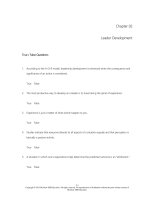Lecture Leadership: Enhancing the lessons of experience (4/e) – Chapter 11
Bạn đang xem bản rút gọn của tài liệu. Xem và tải ngay bản đầy đủ của tài liệu tại đây (489.33 KB, 12 trang )
111
McGrawHill/Irwin
© 2002 The McGrawHill Companies, Inc., All Rights Reserved.
C
HAPTER
E
LEVEN
Characteristics of the
Situation
Current Research That Explores How 113
Situational Factors Affect Leaders’ Behaviors
• Role theory
• Multipleinfluence model
• Situational levels
McGrawHill/Irwin
© 2002 The McGrawHill Companies, Inc., All Rights Reserved.
Leadership Is a Process, Not a
Position
Leader
Situation
Ta
Or
En ga sk
vi niz
ro
nm atio
en n
t
Followers
McGrawHill/Irwin
© 2002 The McGrawHill Companies, Inc., All Rights Reserved.
114
New Operating Assumptions Of
the Information Age
• Cross Functions – Organizations operate with
integrated business processes that cut across
departments.
• Links to customers – Today’s organization’s integrate
supply, production, and delivery processes and realize
enormous improvements in cost, quality, and response
time.
• Customer segmentation – Informationage companies
must learn to offer customized products and services
to diverse customer segments.
McGrawHill/Irwin
© 2002 The McGrawHill Companies, Inc., All Rights Reserved.
115
New Operating Assumptions Of the
Information Age, continued
116
• Global scale – Companies compete against the best
companies throughout the entire world.
• Innovation – Companies must be masters at anticipating
customers’ future needs, innovating new products and
services, and rapidly deploying new technologies into
efficient delivery processes.
• Knowledge workers – All employees must contribute
value by what they know and by the information they
can provide.
McGrawHill/Irwin
© 2002 The McGrawHill Companies, Inc., All Rights Reserved.
117
A Congruence Model
Informal
Informal
Organization
Organization
Input
Input
Environment
Environment
Resources
Resources
Output
Output
System
System
Strategy
Strategy
Formal
Formal
Organization
Organization
Work
Work
History
History
Unit
Unit
Individual
Individual
People
People
McGrawHill/Irwin
© 2002 The McGrawHill Companies, Inc., All Rights Reserved.
Job Characteristics
•
•
•
•
•
McGrawHill/Irwin
Skill variety
Task identity
Task significance
Autonomy
Feedback
© 2002 The McGrawHill Companies, Inc., All Rights Reserved.
118
Task
interdependence
the degree to which tasks require
coordination and synchronization in order
for work groups or teams to accomplish
desired goals
Situational Levels In Which
Leaders and Followers Operate
• Level of authority – one’s
hierarchical level in an organization.
• Organizational structure – the way an
organization’s activities are
coordinated and controlled.
• Organizational design – How do I
want to divide up the work? How do I
want the divisions to coordinate their
work?
McGrawHill/Irwin
© 2002 The McGrawHill Companies, Inc., All Rights Reserved.
1110
Situational Levels In Which Leaders and
Followers Operate, continued
• Lateral interdependence – the degree of
coordination or synchronization required
between organizational units to
accomplish goals.
• Organizational culture – a system of
shared backgrounds, norms, values or
beliefs among members of a group.
McGrawHill/Irwin
© 2002 The McGrawHill Companies, Inc., All Rights Reserved.
1111
Schein’s Four Key Organizational
Culture Factors
•
•
•
•
Myths and stories
Symbols and artifacts
Rituals
Language
McGrawHill/Irwin
© 2002 The McGrawHill Companies, Inc., All Rights Reserved.
1112









